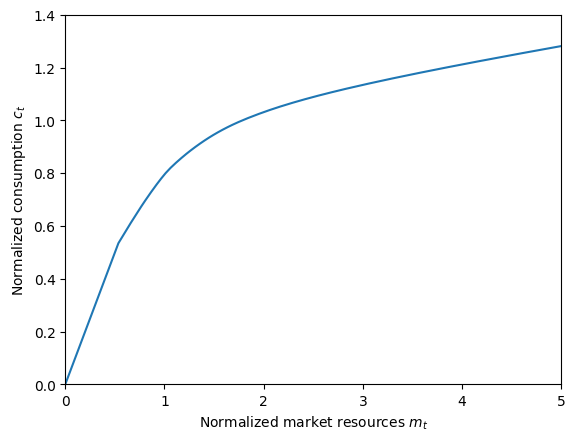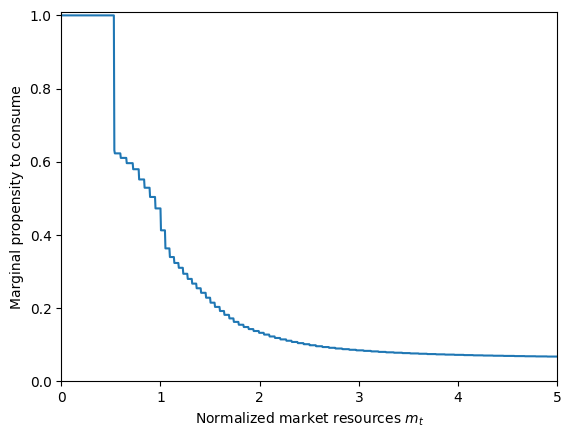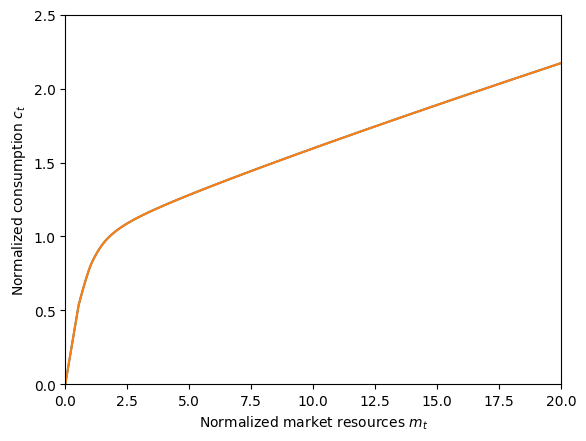This page was generated from
examples/ConsPortfolioModel/RiskyAssetConsumerType.ipynb.
Interactive online version: .
Download notebook.
.
Download notebook.
Interactive online version:
Assets with Risky Returns: Portfolio Choice#
[1]:
from time import time
from HARK.ConsumptionSaving.ConsIndShockModel import (
IndShockConsumerType,
IndShockConsumerType_constructors_default,
)
from HARK.ConsumptionSaving.ConsPortfolioModel import (
PortfolioConsumerType,
init_portfolio,
)
from HARK.ConsumptionSaving.ConsRiskyAssetModel import (
RiskyAssetConsumerType,
IndShockRiskyAssetConsumerType_constructor_default,
)
from HARK.utilities import plot_funcs, plot_funcs_der
import matplotlib.pyplot as plt
[2]:
mystr = lambda number: f"{number:.4f}"
Idiosyncratic Income Shocks Consumer Type#
[3]:
# Make a dictionary for the idiosyncratic shocks type that uses common values from the portfolio type
common_dict = init_portfolio.copy()
common_dict["constructors"] = IndShockConsumerType_constructors_default
common_dict["CRRA"] = 5.0 # but make them pretty risk averse
[4]:
# Make and solve an example consumer with idiosyncratic income shocks
# Use init_portfolio parameters to compare to results of PortfolioConsumerType
IndShockExample = IndShockConsumerType(**common_dict)
IndShockExample.cycles = 0 # Make this type have an infinite horizon
[5]:
start_time = time()
IndShockExample.solve()
end_time = time()
print(
"Solving a consumer with idiosyncratic shocks took "
+ mystr(end_time - start_time)
+ " seconds.",
)
IndShockExample.unpack("cFunc")
Solving a consumer with idiosyncratic shocks took 0.4361 seconds.
[6]:
# Plot the consumption function and MPC for the infinite horizon consumer
plt.xlabel(r"Normalized market resources $m_t$")
plt.ylabel(r"Normalized consumption $c_t$")
plt.ylim(0.0, 1.4)
plot_funcs(IndShockExample.cFunc[0], 0.0, 5.0)
plt.xlabel(r"Normalized market resources $m_t$")
plt.ylabel(r"Marginal propensity to consume")
plt.ylim(0.0, 1.01)
plot_funcs_der(IndShockExample.cFunc[0], 0.0, 5.0)


Risky Return Consumer Type#
[7]:
# Make and solve an example consumer with risky returns to savings
# Use init_portfolio parameters to compare to results of PortfolioConsumerType
temp_dict = common_dict.copy()
temp_dict["constructors"] = IndShockRiskyAssetConsumerType_constructor_default
RiskyReturnExample = RiskyAssetConsumerType(**temp_dict)
RiskyReturnExample.cycles = 0 # Make this type have an infinite horizon
[8]:
start_time = time()
RiskyReturnExample.solve()
end_time = time()
print(
"Solving a consumer with risky returns took "
+ mystr(end_time - start_time)
+ " seconds.",
)
RiskyReturnExample.unpack("cFunc")
Solving a consumer with risky returns took 3.4542 seconds.
[9]:
# Plot the consumption function and MPC for the risky asset consumer
plt.xlabel(r"Normalized market resources $m_t$")
plt.ylabel(r"Normalized consumption $c_t$")
plt.ylim(0.0, 1.4)
plot_funcs(RiskyReturnExample.cFunc[0], 0.0, 5.0)
plt.xlabel(r"Normalized market resources $m_t$")
plt.ylabel(r"Marginal propensity to consume")
plt.ylim(0.0, 1.01)
plot_funcs_der(RiskyReturnExample.cFunc[0], 0.0, 5.0)

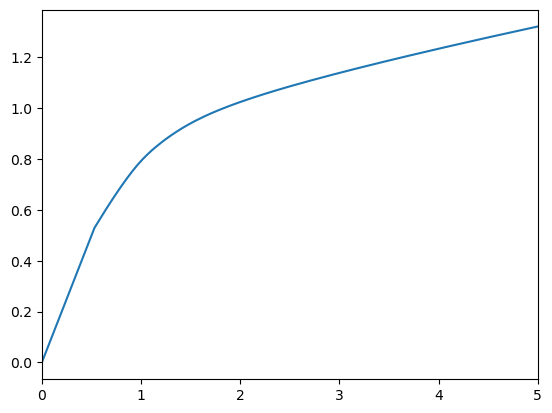
Compare Idiosyncratic Income Shocks with Risky Return#
[10]:
# Compare the consumption functions for the various agents in this notebook.
plt.xlabel(r"Normalized market resources $m_t$")
plt.ylabel(r"Normalized consumption $c_t$")
plt.ylim(0.0, 2.5)
plot_funcs(
[
IndShockExample.cFunc[0], # blue
RiskyReturnExample.cFunc[0], # orange
],
0.0,
20.0,
)

Risky Return Consumer Type with Portfolio Choice#
[11]:
# Make and solve an example risky consumer with a portfolio choice
temp_dict["PortfolioBool"] = True
PortfolioChoiceExample = RiskyAssetConsumerType(**temp_dict)
PortfolioChoiceExample.cycles = 0 # Make this type have an infinite horizon
[12]:
start_time = time()
PortfolioChoiceExample.solve()
end_time = time()
print(
"Solving a consumer with risky returns and portfolio choice took "
+ mystr(end_time - start_time)
+ " seconds.",
)
PortfolioChoiceExample.unpack("cFunc")
PortfolioChoiceExample.unpack("ShareFunc")
Solving a consumer with risky returns and portfolio choice took 3.4221 seconds.
[13]:
# Plot the consumption function and MPC for the portfolio choice consumer
plt.xlabel(r"Normalized market resources $m_t$")
plt.ylabel(r"Normalized consumption $c_t$")
plt.ylim(0.0, 1.4)
plot_funcs(PortfolioChoiceExample.cFunc, 0.0, 5.0)
plt.xlabel(r"Normalized market resources $m_t$")
plt.ylabel(r"Marginal propensity to consume")
plt.ylim(0.0, 1.01)
plot_funcs_der(PortfolioChoiceExample.cFunc, 0.0, 5.0)

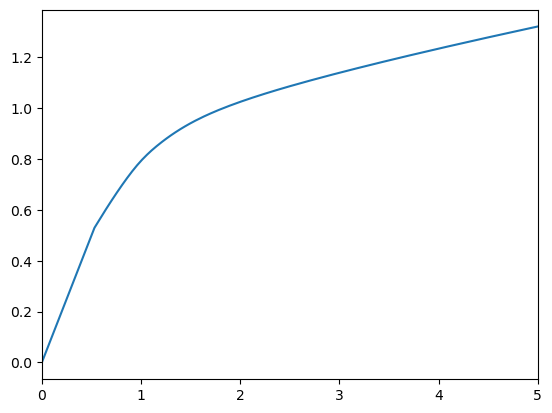
[14]:
plt.xlabel(r"Normalized market resources $m_t$")
plt.ylabel(r"Risky portfolio share $s_t$")
plt.ylim(0.0, 1.01)
plot_funcs(PortfolioChoiceExample.ShareFunc, 0.0, 100.0)
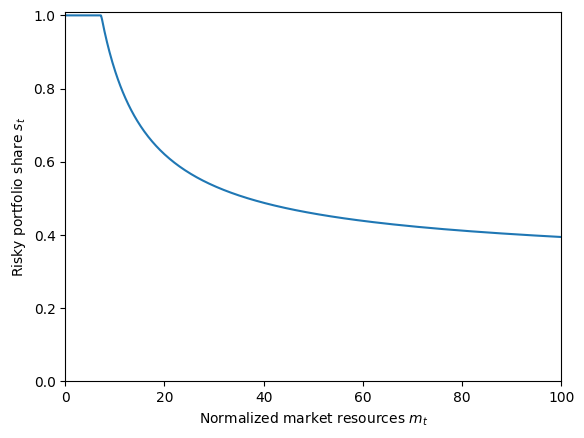
Compare Income Shocks, Risky Return, and RR w/ Portfolio Choice#
[15]:
# Compare the consumption functions for the various agents in this notebook.
plt.xlabel(r"Normalized market resources $m_t$")
plt.ylabel(r"Normalized consumption $c_t$")
plt.ylim(0.0, 2.5)
plot_funcs(
[
IndShockExample.cFunc[0], # blue
RiskyReturnExample.cFunc[0], # orange
PortfolioChoiceExample.cFunc[0], # green
],
0.0,
20.0,
)

Portfolio Consumer Type#
[16]:
# Make and solve an example portfolio choice consumer
PortfolioTypeExample = PortfolioConsumerType(
CRRA=5.0
) # default parameters with higher risk aversion
PortfolioTypeExample.cycles = 0 # Make this type has an infinite horizon
[17]:
start_time = time()
PortfolioTypeExample.solve()
end_time = time()
print(
"Solving a consumer with portfolio choice took "
+ mystr(end_time - start_time)
+ " seconds.",
)
PortfolioTypeExample.unpack("cFuncAdj")
PortfolioTypeExample.unpack("ShareFuncAdj")
Solving a consumer with portfolio choice took 10.4243 seconds.
[18]:
# Plot the consumption function and MPC for the portfolio choice consumer
plt.xlabel(r"Normalized market resources $m_t$")
plt.ylabel(r"Normalized consumption $c_t$")
plt.ylim(0.0, 1.4)
plot_funcs(PortfolioTypeExample.cFuncAdj[0], 0.0, 5.0)
plt.xlabel(r"Normalized market resources $m_t$")
plt.ylabel(r"Marginal propensity to consume")
plt.ylim(0.0, 1.01)
plot_funcs_der(PortfolioTypeExample.cFuncAdj[0], 0.0, 5.0)


Compare RR w/ Portfolio Choice vs Portfolio Choice Type#
[19]:
# Compare the consumption functions for the various portfolio choice types.
plt.xlabel(r"Normalized market resources $m_t$")
plt.ylabel(r"Normalized consumption $c_t$")
plt.ylim(0.0, 2.5)
plot_funcs(
[
PortfolioTypeExample.cFuncAdj[0], # blue
PortfolioChoiceExample.cFunc[0], # orange
],
0.0,
20.0,
)
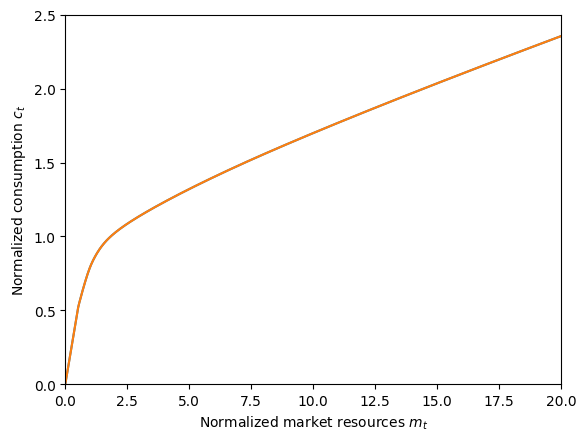
[20]:
# Compare the share functions for the various portfolio choice types.
plt.xlabel(r"Normalized market resources $m_t$")
plt.ylabel(r"Risky asset share $s_t$")
plt.ylim(0.0, 1.01)
plot_funcs(
[
PortfolioTypeExample.ShareFuncAdj[0], # blue
PortfolioChoiceExample.ShareFunc[0], # orange
],
0,
100,
)


